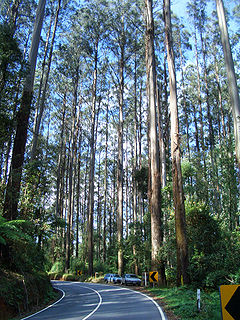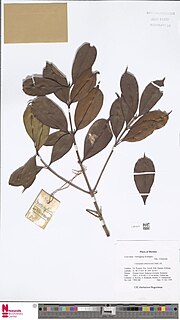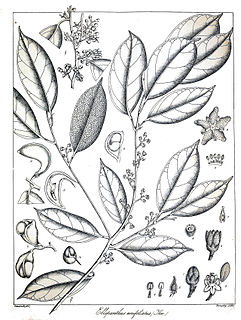
A forest is an area of land dominated by trees. Hundreds of definitions of forest are used throughout the world, incorporating factors such as tree density, tree height, land use, legal standing and ecological function. The Food and Agriculture Organization defines a forest as land spanning more than 0.5 hectares with trees higher than 5 meters and a canopy cover of more than 10 percent, or trees able to reach these thresholds in situ. It does not include land that is predominantly under agricultural or urban land use. Using this definition FRA 2020 found that forests covered 4.06 billion hectares or approximately 31 percent of the global land area in 2020 but are not equally distributed around the globe.

Eucalyptus regnans, known variously as mountain ash, swamp gum, or stringy gum, is a species of medium-sized to very tall forest tree that is native to Tasmania and Victoria, Australia. It is a straight-trunked tree with smooth grey bark, but with a stocking of rough brown bark at the base, glossy green, lance-shaped to curved adult leaves, flower buds in groups of between nine and fifteen, white flowers and cup-shaped or conical fruit. It is the tallest of all flowering plants; the tallest measured living specimen, named Centurion, stands 100.5 metres tall in Tasmania.

Odoardo Beccari was an Italian naturalist who discovered the titan arum, the plant with the largest unbranched inflorescence in the world, in Sumatra in 1878. This botanist is denoted by the author abbreviation Becc. when citing a botanical name.

Cratoxylum arborescens is a plant in the family Hypericaceae. The specific epithet arborescens is from the Latin meaning "tree-like".

Cratoxylum maingayi is a plant in the family Hypericaceae. It is named for the botanist Alexander Carroll Maingay.
Kibara coriacea is a plant in the family Monimiaceae. The specific epithet coriacea is from the Latin meaning "leathery", referring to the leaves.
Mastixia glauca is a tree in the family Nyssaceae. The specific epithet glauca is from the Greek meaning "bluish-grey", referring to the colour of the leaf underside.
Dryobalanops beccarii, or Kapur Keladan, is a species of plant in the family Dipterocarpaceae. The species is named after Odoardo Beccari, 1843–1920, an Italian explorer and botanist. It is found in Peninsular Malaysia and Borneo. It is a large emergent tree, up to 65 m tall, found in mixed dipterocarp forests on shallow leached soils over both sandstone and shale. It is a heavy hardwood sold under the trade names of Kapur. It is recorded from at least four protected areas.

In botany, a tree is a perennial plant with an elongated stem, or trunk, supporting branches and leaves in most species. In some usages, the definition of a tree may be narrower, including only woody plants with secondary growth, plants that are usable as lumber or plants above a specified height. In wider definitions, the taller palms, tree ferns, bananas, and bamboos are also trees. Trees are not a taxonomic group but include a variety of plant species that have independently evolved a trunk and branches as a way to tower above other plants to compete for sunlight. Trees tend to be long-lived, some reaching several thousand years old. Trees have been in existence for 370 million years. It is estimated that there are some three trillion mature trees in the world.
Aulandra beccarii is a plant in the family Sapotaceae. It grows as a small tree. The twigs are reddish brown. Flowers are pale yellow. A. beccarii is endemic to Borneo.
Diospyros beccarioides is a tree in the family Ebenaceae. It grows up to 20 metres (70 ft) tall. Twigs are reddish brown when young. Inflorescences bear three or more flowers. The fruits are roundish, up to 2.5 cm (1 in) in diameter. The tree is named for its resemblance to Diospyros beccarii, a synonym of Diospyros sumatrana. Habitat is lowland limestone hills from sea level to 200 metres (700 ft) altitude. D. beccarioides is found in Sumatra, Borneo and Sulawesi.
Aglaia beccarii is a tree in the family Meliaceae. It grows up to 25 metres (80 ft) tall with a trunk diameter of up to 30 centimetres (12 in). The bark is greyish brown, greenish brown or white. The fruits are pink or reddish purple. The tree is named for the Italian botanist Odoardo Beccari. Habitat is forests from sea-level to 1,500 metres (5,000 ft) altitude. A. beccarii is found in Borneo and the Philippines.
Canarium pilosum is a tree in the family Burseraceae. The specific epithet pilosum is from the Latin meaning "hairy", referring to the soft hairs of the twigs and leaves.
Dacryodes longifolia is a tree in the family Burseraceae. The specific epithet longifolia is from the Latin meaning "long leaf".

Dacryodes rostrata is a tree in the family Burseraceae. The specific epithet rostrata is from the Latin meaning "beaked", referring to the narrow-tipped leaves.

Ellipanthus is a genus of plants in the family Connaraceae. The generic name is from the Greek meaning "defective flower", referring to the incomplete development of some of the stamens.
Ellipanthus tomentosus is a plant in the family Connaraceae. The specific epithet tomentosus is from the Latin meaning "thickly covered with hairs", referring to the leaves.
Mastixia trichotoma is a tree in the family Nyssaceae. The specific epithet trichotoma is from the Greek meaning "three parts", referring to the three-branched inflorescence.

Cratoxylum glaucum is a plant in the family Hypericaceae. The specific epithet glaucum is from the Latin meaning "blue-green", referring to the colour of the leaf underside.
Lithocarpus gracilis is a tree in the beech family Fagaceae. The specific epithet gracilis is from the Latin meaning "slender", referring to the twigs.








